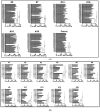Use of Biolayer Interferometry to Identify Dominant Binding Epitopes of Influenza Hemagglutinin Protein of A(H1N1)pdm09 in the Antibody Response to 2010-2011 Influenza Seasonal Vaccine
- PMID: 37631875
- PMCID: PMC10458479
- DOI: 10.3390/vaccines11081307
Use of Biolayer Interferometry to Identify Dominant Binding Epitopes of Influenza Hemagglutinin Protein of A(H1N1)pdm09 in the Antibody Response to 2010-2011 Influenza Seasonal Vaccine
Abstract
The globular head domain of influenza virus surface protein hemagglutinin (HA1) is the major target of neutralizing antibodies elicited by vaccines. As little as one amino acid substitution in the HA1 can result in an antigenic drift of influenza viruses, indicating the dominance of some epitopes in the binding of HA to polyclonal serum antibodies. Therefore, identifying dominant binding epitopes of HA is critical for selecting seasonal influenza vaccine viruses. In this study, we have developed a biolayer interferometry (BLI)-based assay to determine dominant binding epitopes of the HA1 in antibody response to influenza vaccines using a panel of recombinant HA1 proteins of A(H1N1)pdm09 virus with each carrying a single amino acid substitution. Sera from individuals vaccinated with the 2010-2011 influenza trivalent vaccines were analyzed for their binding to the HA1 panel and hemagglutination inhibition (HI) activity against influenza viruses with cognate mutations. Results revealed an over 50% reduction in the BLI binding of several mutated HA1 compared to the wild type and a strong correlation between dominant residues identified by the BLI and HI assays. Our study demonstrates a method to systemically analyze antibody immunodominance in the humoral response to influenza vaccines.
Keywords: dominant binding epitope; humoral response; influenza vaccine.
Conflict of interest statement
The authors declare no conflict of interest.
Figures




References
-
- Henry C., Palm A.-K.E., Utset H.A., Huang M., Ho I.Y., Zheng N.-Y., Fitzgerald T., Neu K.E., Chen Y.-Q., Krammer F., et al. Monoclonal Antibody Responses after Recombinant Hemagglutinin Vaccine versus Subunit Inactivated Influenza Virus Vaccine: A Comparative Study. J. Virol. 2019;93:e01150-19. doi: 10.1128/JVI.01150-19. - DOI - PMC - PubMed
-
- Nachbagauer R., Feser J., Naficy A., Bernstein D.I., Guptill J., Walter E.B., Berlanda-Scorza F., Stadlbauer D., Wilson P.C., Aydillo T., et al. A chimeric hemagglutinin-based universal influenza virus vaccine approach induces broad and long-lasting immunity in a randomized, placebo-controlled phase I trial. Nat. Med. 2021;27:106–114. doi: 10.1038/s41591-020-1118-7. - DOI - PubMed
LinkOut - more resources
Full Text Sources
Research Materials

